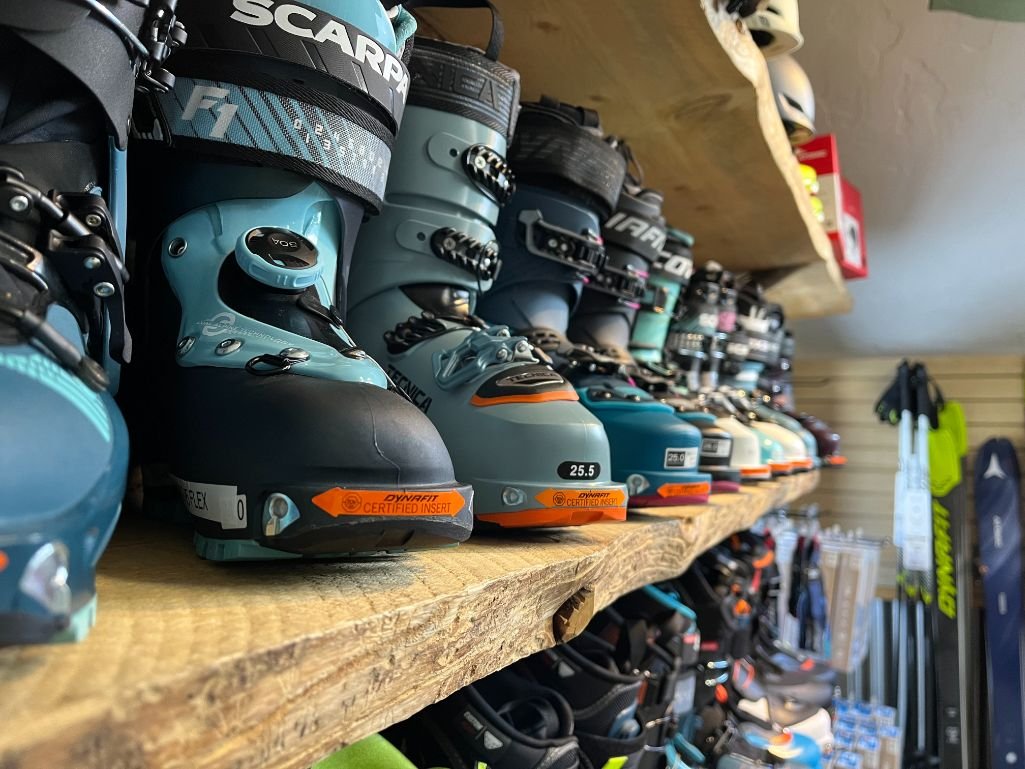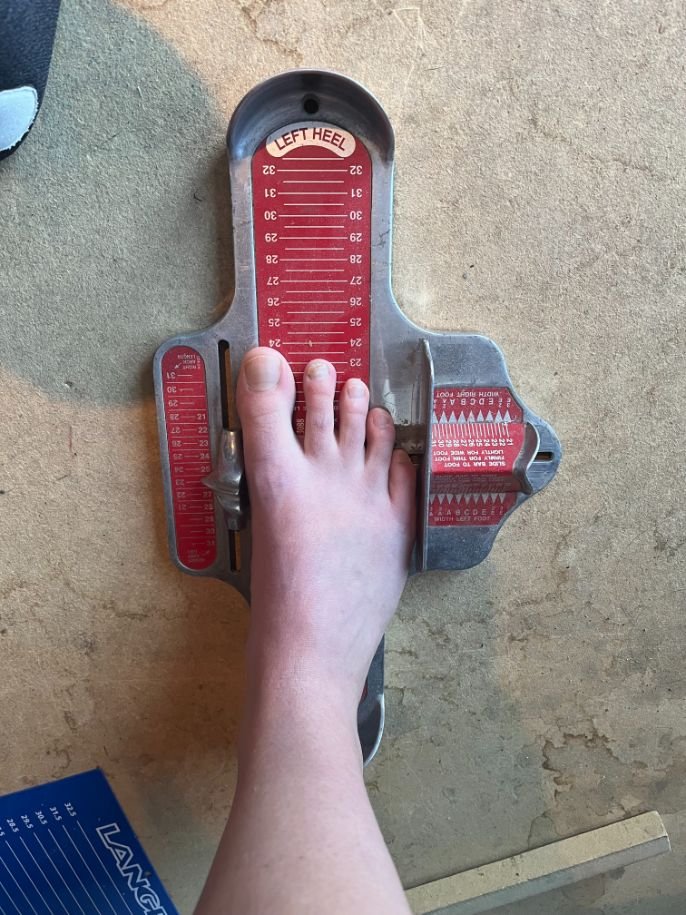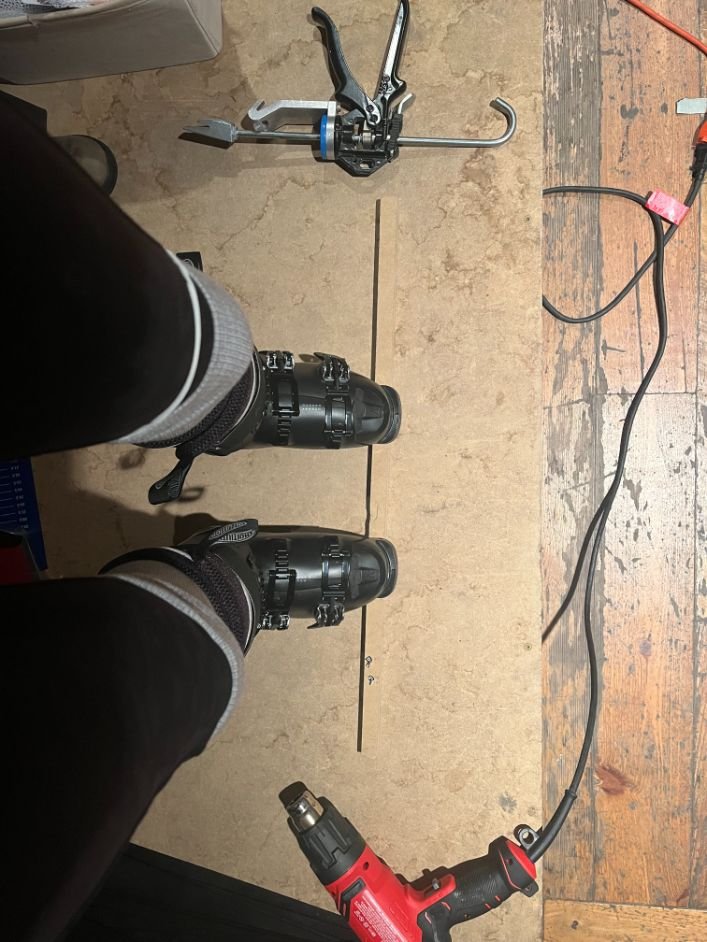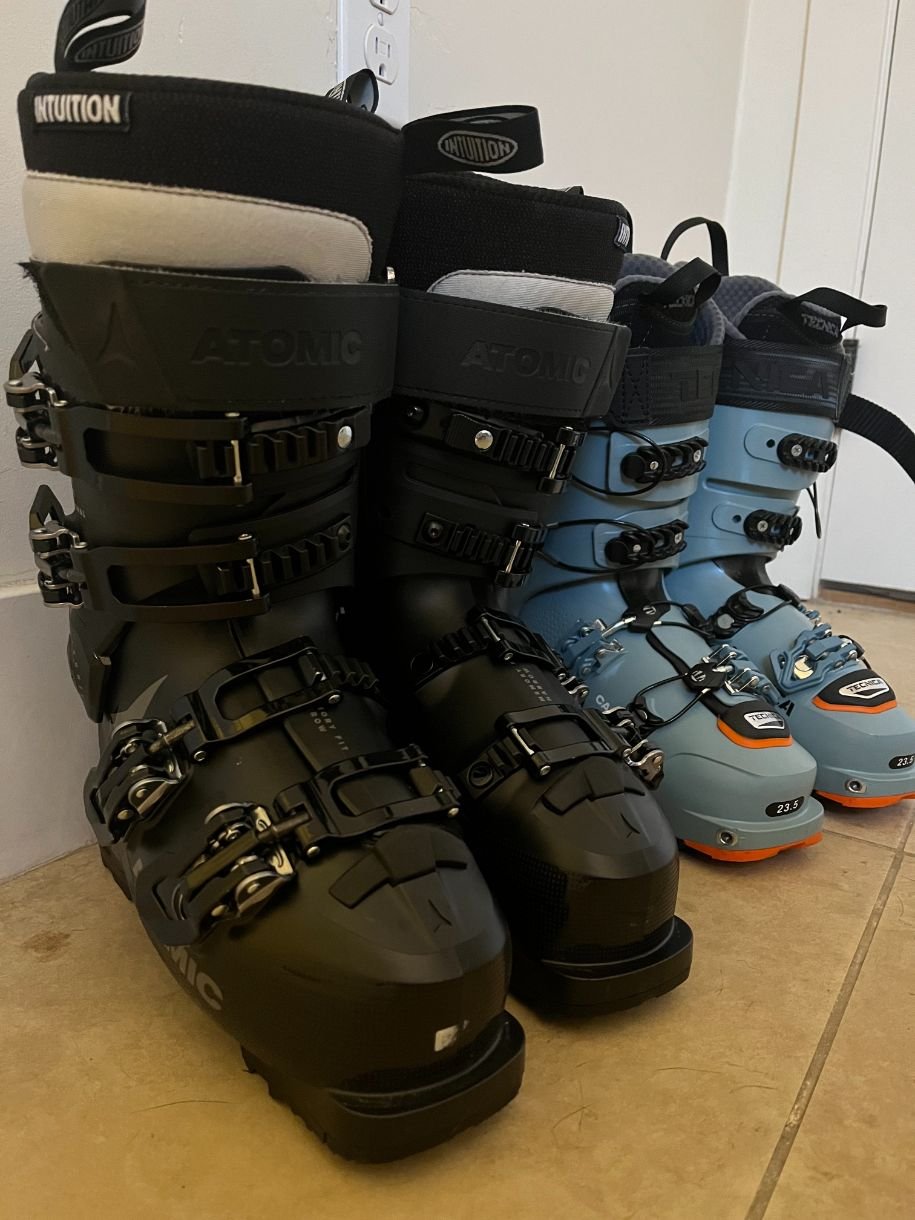Ski Boot Sizing: What Size Ski Boot Do I Need?
the most important piece of ski equipment: How to choose ski boots for the resort
Updated December 15th, 2024
Home > How to Choose Gear
Ask any die-hard skier what the most essential piece of equipment is—almost all of them will say ski boots.
While it may seem that these hard, plastic boots were invented as torture devices for human feet, they serve a very specific purpose for skiing.
And while ski boots will never (or should never) feel like your favorite pair of slippers, you don’t have to boot up for every ski day in pain.
In this guide, we discuss ski boot sizing to answer the question "what size ski boot do I need?" that is common among skiers. We will show you how to choose the best ski boots for your feet for resort skiing.
We’re writing a guide on finding the right ski boots for you, not a guide on the 10 best ski boots. Here’s why: more than any other ski gear, boots need to fit your foot right to perform well, and everyone’s feet are different. While one boot might be perfect for me, it could be a horrible option for you.
So, instead of reviewing ski boots, we’d like to guide you on how to find the best ski boots for you—based on your foot shape, skiing type, and preferences. Our writer has spent nearly a decade in the outdoor and ski industry testing gear. When she’s not writing, she works at a ski shop in Breckenridge, Colorado, where she assists customers on all things ski gear, including boot fitting. She’s helped dozens of skiers of all levels find the right boots.
We create reader-supported, objective gear reviews independently selected by our editors. This story may contain affiliate links, which help fund our website. When you click on the links to purchase gear, we may get a commission, without costing you an extra cent. Thank you for supporting our work and mission of outdoor coverage for every body! Learn more.
1. Why you should use a boot outfitter
Stasia Stockwell works at a ski shop in Colorado and shares advice on sizing ski boots.
It’s easy to find ski boots online, and plenty of people buy them without trying them on; it’s a gamble at best. Our recommendation (and that of almost all industry professionals): go to a good boot fitter. To milk the most performance out of these very expensive and weird shoes, you need to ensure a proper fit. We wholeheartedly believe it’s worth the time and money to go to a local shop and work with a boot fitter.
A good boot fitter can size you correctly (ski boots don’t directly correlate with shoe size). They’ll also be able to get you into a boot that best matches your foot shape, making the boot more comfortable and better performing overall. Going to a boot fitter also gives you the option for fit customizations if you need them, like footbeds, heat molds, and shell punches. You can’t get this expertise online; the boot fitter needs to look at your foot to know the best boot for you.
How do you know you’ve found a good boot fitter?
Start by looking for shops with knowledge, expertise, and a good reputation. The person fitting you for ski boots should ask questions about your skiing style, preferences, and foot pain concerns. They should look at your foot, measure it, and perform shell fits with each boot. Consider another shop if the boot fitter you’re working with is not doing this.
It is well worth going to a ski shop that makes you feel welcome, no matter your skill level or how you got into the sport. It’s not uncommon for folks in the ski industry to be elitist and sometimes less than welcoming.
Don’t spend your time or money at a shop that isn’t stoked to help you out. And rest assured, while there are shops that may snub new or inexperienced folks, there are many more that are incredibly kind, helpful, and welcoming; seek out those shops. A good shop and good boot fitter will help guide you through the process, offering as much info and help as you need to understand how to find the right boots for you.
Only go into a shop for a boot fitting if you have genuine intentions to purchase your boots from that shop. Sometimes you don’t find the right thing and walk out empty handed, and that’s okay. But you should never take up hours of a shop’s and boot fitter’s time only to turn around and find some boots you like online for cheaper.
Boot fitting is one of the things that makes small local shops valuable to communities (as compared to online retailers), and they cannot stay in business if they can’t sling some product. Most shops do not charge extra for a basic boot fitting; it is a service that comes with buying boots from them. So please, if you go to a shop for a boot fitting and find a pair that works, buy from that shop.
2. How to find the right size
A Brannock is a tool that a boot fitter will use to measure your feet for a ski boot.
Unlike shoe sizing, ski boot sizing is measured in centimeters—this is called Mondo Point sizing. A boot fitter will use a device (often a simple tool called a Brannock, sometimes something more techy and advanced) to measure the length and width of your foot. Your foot length will determine your starting point for ski boot size. For example, if your foot is 23 centimeters long, you will probably wear a size 23 Mondo size ski boot.
To find the right shell size: After you’ve measured your foot, finding the right shell size is next. For the shell fit, you’ll try the ski boot shell on with the liner removed. This step shows how your foot fits into the boot and helps determine if you’re in the correct size.
With your toes just touching the front of the boot, there should be a small gap between the back of the boot and your heel, typically between 1-2 centimeters. Less than 1 centimeter of space will be too small; more than 2 centimeters will probably be too big.
Find the right fit: A snugger, 1-centimeter fit will offer more of a performance fit, but less comfort, and a more spacious, 2-centimeter fit will do the opposite. If you are an advanced skier and tend to ski aggressively, you’ll want to opt for a performance fit. If you're an intermediate skier looking to keep it mellow and want the most comfort you can get from your boots, give your foot a little more space with a comfort fit.
A note on half sizes: They don’t really exist. Ski boot shells come only in full sizes. Certain ski boot manufacturers will pre-mold the liner to fit more like a half size, but the shell will be the same. 27 and 27.5 ski boots are in the same size shell. So, don’t let yourself get hung up on half sizes. Your liner will break in and form to your foot; most can be heat molded if necessary.
3. How to Consider boot volume and foot shape
After determining your foot length and finding the right ski boot size, you’ll want to consider volume.
Consider your heel volume. It should feel snug in the back of the boot but without pain.
By volume, we mean the width (or last) and vertical space in the boot. Most ski boots marketed to skiers (i.e., not professional race boots) will have a last (width) in the range of 92-103 millimeters.
Measuring the widest part of your foot will help to determine which last will fit your foot the best.
Similarly, you’ll want to consider how much vertical space is in the boot compared to your foot volume.
You'll likely want a higher volume boot if you have a high instep or high arch.
A lower-volume boot will offer a better fit if you’ve got a normal-to-low instep and arch.
How should a good-fitting boot feel? In a good-fitting boot, you should be able to wiggle your toes a little, but your foot shouldn’t slide around at all (when the boot is buckled). Snug pressure is a good thing; pain is not. A good boot fitter should be able to help skiers with an especially narrow foot, or wide foot get the correct size.
A boot that is too narrow for your foot will likely create a pressure point (or more than one), often in the ball of your foot or on your fifth metatarsal. But, an excessively wide boot will allow your foot to move from side to side, giving you less control overall when skiing.
Consider your heel: The last thing to consider here is the heel pocket of the boot. Your heel should be nice and snug in the back of the boot. You should not be in pain from pressure points, but you shouldn’t be able to move around in there too much, either.
4. What flex is on a ski boot and why it matters
A downhill oriented ski boot that can also work for backcountry skiing.
Ski boot flex refers to the stiffness of the plastic the boot is made of.
How stiff your boot is will depend on a couple of main factors:
1) how aggressively you ski
2) your overall body size
More often than not (though certainly not a hard rule):
a taller, heavier person will benefit from a stiffer flex;
a shorter, lighter person will have an easier time flexing a softer boot.
The most crucial factor in deciding what flex you need is skiing style and ability. You'll enjoy a softer boot if you’re new to the sport or prefer a more casual skiing style. But if you ski very hard and aggressively, you’ll need a stiffer boot to match that style.
Flex ratings in downhill ski boots range from as low as 60 to 130 and up, with higher numbers indicating stiffer flex and lower numbers indicating softer ones (most boots stiffer than a 130 flex are race boots).
Shell fitting for ski boots.
It’s worth noting that flex ratings are not standardized across the industry, so a 120 flex in one boot or brand might feel slightly different than another brand’s 120 flex.
Having the proper flex for you and your skiing style will help your overall performance. When you flex your ski boot and lean into a turn, that power transfer from the boot to the binding to the ski is what drives the turn.
A boot that is too soft for you will lack power and feel sloppy, but a boot that is too stiff will feel like a brick wall against your shin.
Standing in the boots in a ski stance while flexing the boots forward will help you determine the right flex for you. With a few questions, a good boot fitter should also be able to recommend a good flex range for you.
5. Heat molding and other boot-fitting techniques
Making custom food beds for ski boots.
After you’ve found the best boot for you, there are tweaks you can make to customize them more if necessary. Footbeds are always a great addition—they’ll conform to your foot arch and help to take up any unnecessary volume in the boot, making it more comfortable and better performing overall.
Most ski boots on the market today include heat-moldable liners. With heat-moldable liners, a boot fitter can heat the liners to a specific temperature before you put the boots on. Then, you stand in the boots for several minutes to allow the warm foam liner to conform to your feet. Many skiers like heat molding no matter what. However, we recommend heat molding only if you find it necessary due to pressure points in the boots.
While heat molding can offer more initial comfort, it ultimately wears out the liners a little bit quicker. Plus, as the liners wear, they pack out, eventually to the point of being ineffective. You always want your boots to fit as snugly as possible without causing pain, and heat molding only creates space in the boot. So, if you’ve got pressure points that need to be resolved, get them heat molded, and your feet will feel better. But, if your feet are happy in the boots without the liners being heat-molded, leave them be.
Heat molding liners for ski boots.
Another option for folks with foot pain in their boots is punching the shell. This technique is done by expert boot fitters, where the shell is altered in a specific spot to create space and relieve pressure points. It’s most commonly done near the ball of the foot, especially for feet with bunions, or on the outer edge of the foot, near the fifth metatarsal.
These customizations can help your ski boots be as comfortable and high-performing as possible. And while they’re helpful for many skiers, they’re not always necessary.
Finding the right size and perfect boot fit (or as close as you can get) in the first place is the best thing you can do to keep your feet happy while you’re skiing.
It’s also worth noting that you should do these customizations in a shop with a trained boot fitter. Microwaving your boot liner for an at-home heat mold is a bad idea.
6. How to take care of your ski boots
Now that you’ve taken the time to get the best-fitting ski boots for your feet, it’s worth taking care of them to get as many ski days out of them as possible.
First, the golden rule of ski boot storage: Always keep your boot buckles buckled. This practice helps them maintain their shape and keeps the plastic intact, ultimately helping your boots to last longer. Each time you set your boots aside, whether for the night or the season, make sure they’re buckled.
Second, dry your liners. If you’ve skied so hard that your liners are damp after a deep powder day or some warm spring laps, pull them out and let them dry overnight. This practice will help keep the liners in good shape and free of nasty things like mildew and mold. It’ll also help fend off that dreaded wet ski boot smell. If you put your boots on boot dryers, make sure it’s not hot air. You want them to dry, but you don’t want to be heat molding them every time you put them on.
See our most popular ski gear articles in our Snow Gear Guides:
The author’s ski boots after a daily run on the slopes.
FAQ
How much does a ski boot fitting cost?
In most cases, getting fitted for ski boots does not come with an extra charge. Most shops will do the fitting as a complimentary service in order to sell ski boots. (While you should not go in for a boot fitting if you have no intention of purchasing boots from that shop, you also do not have an obligation to purchase boots there if you do not find something that works for you.)
Getting fitted for ski boots will cost whatever the price of the boots is, plus any additional accessories you opt for, like footbeds. Many shops will heat mold your liners as a complimentary service as well, if you purchased boots from them. But, it is more common that if you require additional modifications, like punching the shells, that there will be an extra charge there (and this price varies depending on the shop, the boot, and the extent of the work needed).
With that being said, ski boots have a very wide price range: Lower end boots may cost only a couple hundred dollars, while top-end performance boots can cost over $1,000. It is a good idea to know your budget beforehand and communicate that with the boot fitter right off the bat. You can expect to spend around $300-$700 for a good pair of boots, and more if you’re looking for a specific type of performance. Typically, ski boots that have a stiffer flex and that are higher performing will cost more. (Much of the reason these higher end boots cost more is because of the specific plastics used to make them.)
The author skiing in Colorado. Of her entire ski set-up, she says ski boots are the most important piece of equipment.
Is ski boot fitting worth it?
Ski boots are, hands down, the most important piece of ski equipment When working with customers as a boot fitter at my local shop, or when giving new-to-skiing friends advice, I always say:
“If you’re going to spend money on one single item, make it your boots. It takes time to get fitted for boots, and you’ll have to buy directly from a retail shop rather than scouring the Web for deals, but it is absolutely worth it. ”
Your boots provide the contact point between your feet and your skis. At best, poor-fitting boots will feel sloppy and won’t allow you to ski at your best; at worst, poor-fitting ski boots can cause pain and even permanent damage to your feet.
It’s a common saying in the industry that you date your skis and marry your boots. This is true. Find a deal on skis somewhere. Save some money by buying more affordable outerwear. Splurge on your boots.
Where can I get fitted for ski boots?
Many ski shops, both big and small, will offer boot fitting. In our opinion, any shop that sells ski boots should have a trained boot fitter on staff to assist with this. If there is not a ski shop near you, consider stopping into one on your next ski trip.
How long does ski boot fitting take?
The initial process of sizing and fitting boots can take anywhere from less than an hour to a few hours. This depends on the customer, their needs, their feet, and other factors. After you’ve found the right pair, you may spend extra time making tweaks, like heat-molding your liners (usually takes around an hour) or punching the shell (the boot-fitter will do this in their shop and will be able to give you an estimate on how long it will take).
What to bring to a ski boot fitting
It is vital that you wear ski socks to your boot fitting appointment. And don’t just wear any old ski socks; bring your favorites, the ones you wear most often. This will give you the best idea of how the boot fits. Do not try on ski boots without wearing ski socks. See our guide to the best wool and synthetic ski sock for recommendations.
It’s also helpful to wear pants that can easily roll up to your knees so they don’t get in the way of the boots. Avoid wearing a skirt to a boot fitting; it’ll probably make things at least a little awkward.
Do ski boots fit the same as shoes?
Ski boots don’t look like normal footwear and they don’t fit like normal footwear either. This is why it’s so helpful to go to a boot fitter. Ski boots are not sized like street shoes (you won’t get a “size 7” ski boot if that’s your shoe size. Ski boots are built to offer performance while skiing; they give you the ultimate amount of power transfer from your legs and feet to the skis themselves. They will fit differently—likely snugger—than any other footwear you have (with the exception of climbing shoes).
Will new ski boots fit old bindings?
Ski boot and binding compatibility depends largely on your boot sole length (commonly referred to as BSL). This is the length, measured in millimeters, from the toes to the heel of the exterior of your boot sole. Generally speaking, if you are replacing your old boots with new ones that are the same boot size on the Mondo Point scale (interior length of the boot measured in centimeters), they will most likely fit in your old bindings.
There are many factors that go into this, including how your bindings were mounted and the type of soles on your boots. A boot fitter or ski tech will be able to answer this question for you, based on your specific gear.
Do ski boots fit all bindings?
While most alpine downhill ski boots fit in most alpine downhill ski bindings, there are exceptions, most often with boots or bindings that are designed for backcountry skiing as well as resort skiing. Always check with your boot fitter or ski tech to be sure of boot and binding compatibility.
Interested in backcountry skiing? Check out our backcountry guides:
Stasia Stockwell skiing in Japan.
About the Author: Why You Should Trust Us
A true mountain dweller, Stasia feels far more at home in the alpine than on a busy city street. She’s worked as a backcountry guide in southeast Alaska and has written for publications like 5280, Backpacker Magazine, and REI Co-op Journal, among others. She’s a lifelong skier, mountain biker, trail runner, and backpacker passionate about lowering barriers to entry for outdoor sports.
Stasia has been skiing since she could walk and has spent every winter she can remember on the slopes. She’s been working in and testing gear for the outdoor and ski industries for nearly a decade. When she’s not writing or skiing, Stasia works part-time at a local backcountry gear shop where she frequently assists with boot fitting. She draws from her experience with decades of skiing and years of professional work in the outdoor industry.
You can see all of Stasia's Treeline Review stories on her author page and her other work on her website.
















